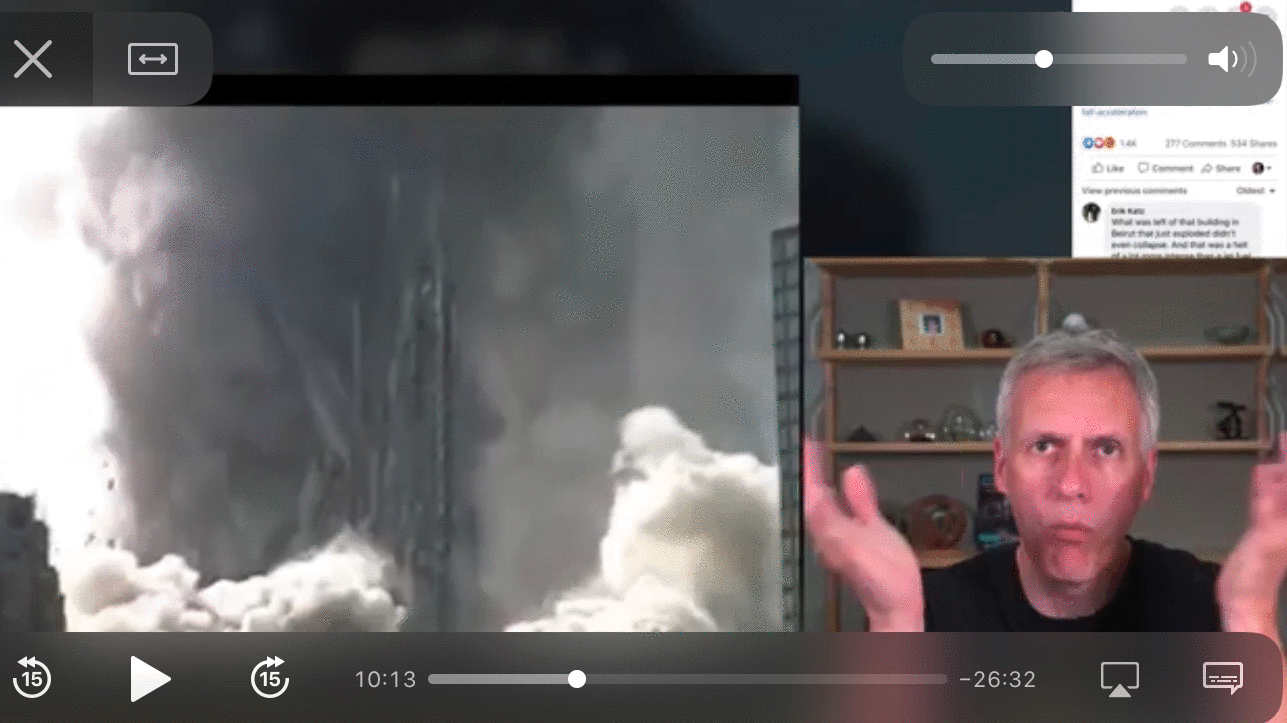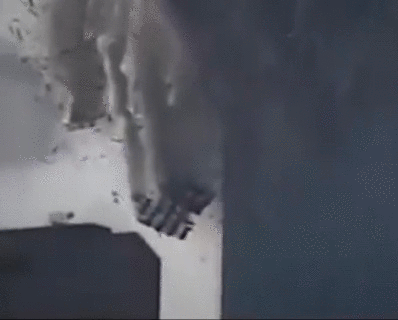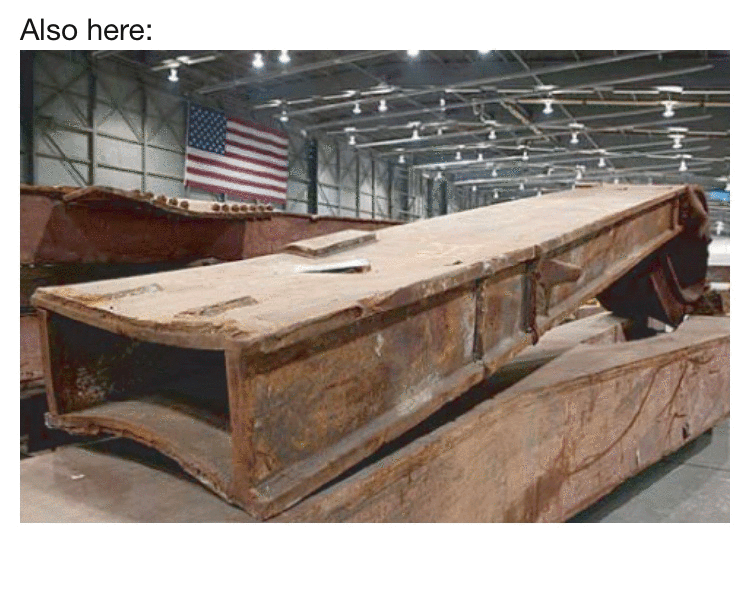It looks like you're using an Ad Blocker.
Please white-list or disable AboveTopSecret.com in your ad-blocking tool.
Thank you.
Some features of ATS will be disabled while you continue to use an ad-blocker.
share:
originally posted by: kwakakev
9/11 Truth Coming Out Fast, Former Spy Ran CIA False Flag Operation and Details All
Robert David Steele does a good presentation discussing false flags, some of the money issues and the corrupt courts coveing up the crime.
Did let things down a bit with the holographic plane theory. Missed a bit on the Pennsylvania plane getting shot out of the sky with such a large debris field. The rest looks good.
So you want to believe another conspiracist loon and his 9/11 mythology over what is actually in the photograph, video, seismic, physical evidence of 9/11.
When the towers and WTC 7 fell into the New Underground, how did that effect the underground dwellers of New York?
See. Two of your favorite conspiracy mythologies you could tie together.....
originally posted by: neutronflux
originally posted by: democracydemo
a reply to: neutronflux
Yes indeed and we witnessed this:
www.metabunk.org...
See you cannot articulate a proper response.
Why would i? You gone and done this already:
the the core columns would have simultaneous pulled down the outer vertical columns (the vertical columns holding up the floor opposite of the core columns, and were part of the towers cores) via the floor trusses.
www.metabunk.org...
originally posted by: democracydemo
originally posted by: neutronflux
originally posted by: democracydemo
a reply to: neutronflux
Yes indeed and we witnessed this:
www.metabunk.org...
See you cannot articulate a proper response.
Why would i? You gone and done this already:
the the core columns would have simultaneous pulled down the outer vertical columns (the vertical columns holding up the floor opposite of the core columns, and were part of the towers cores) via the floor trusses.
www.metabunk.org...
Except when the upper potion of the building above the Jet impact fell into the building below it broke floor connections. The core failing fist does not explain proven floor connections failures.
Failure of Welded Floor Truss Connections from the Exterior Wall during Collapse of the World Trade Center Towers
app.aws.org...
Analysis of the connections supporting the composite floor system of the WTC towers showed that at and below the im- pact floors, the greater majority (above 90%) of the floor truss connections were either bent downward or completely re- moved from the exterior column. This was probably related to the overloading of the floors below the impact region after col- lapse initiation. Depending upon weld joint geometry, detachment of the main load-bearing seats was a result of either fracture in the heat affected zone of the base material (standoff plate detached from spandrel) or through the weld metal (seat angle detached from standoff plate). Failure in both cases was assumed to be a result of a shear mechanism as a result of overloading from floors above impacting those below. There did not appear to be a significant change in distribution of failure modes of the floor truss connections when comparing those connections inside vs. outside of the impact region or those ex- posed to pre-collapse fires and those that were not.
The below is supported by the video, audio, seismic evidence.
The destruction of the Twin Towers has been called "the most infamous paradigm" of progressive collapse.[6] They began with the local failure of a few structural components and progressed to encompass the whole of the structure.[22] Such collapses are characterized by "the separation of structural components (including non-load bearing elements), the release of gravitational energy, and the occurrence of impact forces." The vertical impact force supplies the propagating action, the principal forces are parallel, and the primary load transfer is serial.[23] The key element in the structure that failed was constituted by the combined "vertical load-bearing members of one entire storey." Excepting the top floors of the building, which would not have released sufficient gravitational energy to bring about a total collapse, the collapses could have begun with the failure of any story.[24]
Under these conditions, the towers collapsed symmetrically and more or less straight down, though there was some tilting of the tops of the towers and a significant amount of fallout to the sides. In both cases, the section of the building that had been damaged by the airplanes failed, which allowed the floors above the impact zone to fall onto the undamaged structure below. As the collapse progressed, dust and debris could be seen shooting out of the windows several floors below the advancing destruction, caused by the sudden rush of air from the upper levels.
During each collapse, large portions of the perimeter columns and possibly the cores were left without any lateral support, causing them to fall laterally towards the outside, pushed by the increasing pile of rubble. The result was that the walls peeled off and separated away from the buildings by a large distance (about 500 feet in some cases), hitting other neighboring buildings, and starting fires that would later lead to the collapse of Building 7. Some connections broke as the bolts snapped, leaving many panels randomly scattered.[25] The first fragments of the outer walls of the collapsed North Tower struck the ground 11 seconds after the collapse started, and parts of the South Tower after 9 seconds. The lower portions of both buildings' cores (60 stories of WTC 1 and 40 stories of WTC 2) remained standing for up to 25 seconds after the start of the initial collapse before they too collapsed.[13]
Collapse initiation
After the planes struck the buildings, but before the buildings collapsed, the cores of both towers consisted of three distinct sections. Above and below the impact floors, the cores consisted of what were essentially two rigid boxes; the steel in these sections was undamaged and had undergone no significant heating. The section between them, however, had sustained significant damage and, though they were not hot enough to melt it, the fires were weakening the structural steel.
As a result, the core columns were slowly being crushed, sustaining plastic and creep deformation from the weight of floors above. As the top section tried to move downward, however, the hat truss redistributed the load to the perimeter columns. Meanwhile, the perimeter columns and floors were also being weakened by the heat of the fires, and as the floors began to sag they pulled the exterior walls inwards. "The ensuing loss in vertical load-carrying capacity was confined to a few storeys but extended over the entire cross section of each tower."[26] In the case of 2 WTC, the eastern face finally buckled, transferring its loads back to the failing core through the hat truss and initiating the collapse. Later, the south wall of 1 WTC buckled in the same way, and with similar consequences.[27]
en.m.wikipedia.org...
originally posted by: neutronflux
The below is supported by the video, audio, seismic evidence.
The destruction of the Twin Towers has been called "the most infamous paradigm" of progressive collapse.[6] They began with the local failure of a few structural components and progressed to encompass the whole of the structure.[22] Such collapses are characterized by "the separation of structural components (including non-load bearing elements), the release of gravitational energy, and the occurrence of impact forces." The vertical impact force supplies the propagating action, the principal forces are parallel, and the primary load transfer is serial.[23] The key element in the structure that failed was constituted by the combined "vertical load-bearing members of one entire storey." Excepting the top floors of the building, which would not have released sufficient gravitational energy to bring about a total collapse, the collapses could have begun with the failure of any story.[24]
Under these conditions, the towers collapsed symmetrically and more or less straight down, though there was some tilting of the tops of the towers and a significant amount of fallout to the sides. In both cases, the section of the building that had been damaged by the airplanes failed, which allowed the floors above the impact zone to fall onto the undamaged structure below. As the collapse progressed, dust and debris could be seen shooting out of the windows several floors below the advancing destruction, caused by the sudden rush of air from the upper levels.
During each collapse, large portions of the perimeter columns and possibly the cores were left without any lateral support, causing them to fall laterally towards the outside, pushed by the increasing pile of rubble. The result was that the walls peeled off and separated away from the buildings by a large distance (about 500 feet in some cases), hitting other neighboring buildings, and starting fires that would later lead to the collapse of Building 7. Some connections broke as the bolts snapped, leaving many panels randomly scattered.[25] The first fragments of the outer walls of the collapsed North Tower struck the ground 11 seconds after the collapse started, and parts of the South Tower after 9 seconds. The lower portions of both buildings' cores (60 stories of WTC 1 and 40 stories of WTC 2) remained standing for up to 25 seconds after the start of the initial collapse before they too collapsed.[13]
Collapse initiation
After the planes struck the buildings, but before the buildings collapsed, the cores of both towers consisted of three distinct sections. Above and below the impact floors, the cores consisted of what were essentially two rigid boxes; the steel in these sections was undamaged and had undergone no significant heating. The section between them, however, had sustained significant damage and, though they were not hot enough to melt it, the fires were weakening the structural steel.
As a result, the core columns were slowly being crushed, sustaining plastic and creep deformation from the weight of floors above. As the top section tried to move downward, however, the hat truss redistributed the load to the perimeter columns. Meanwhile, the perimeter columns and floors were also being weakened by the heat of the fires, and as the floors began to sag they pulled the exterior walls inwards. "The ensuing loss in vertical load-carrying capacity was confined to a few storeys but extended over the entire cross section of each tower."[26] In the case of 2 WTC, the eastern face finally buckled, transferring its loads back to the failing core through the hat truss and initiating the collapse. Later, the south wall of 1 WTC buckled in the same way, and with similar consequences.[27]
en.m.wikipedia.org...
Anyone can invent a fantasy like this, the problem is it's not based on reality, and actual demonstration, to PROVE it is anything more than a fairy tale.
Saying what happened is worthless chatter, unless it is supported by real world demonstrations. Nothing else matters here.
You still don't get that, for some reason.
All it comes down to is physics, nothing else matters. Every structure is based on the same physical principles, which are all proven with actual demonstrations. No exceptions.
You cannot avoid the problem with all your side issues, diversions that move away from the only issue that matters here.
There's always a way to 'account' for something, but when it doesn't have to be PROVEN in the real world, with actual demonstrations, it's utterly worthless babble-speak.
As I told you before, every structural collapse, no matter what occurred, whether a total collapse, or partial collapse - are all repeatable with REAL WORLD MODELS.
For example, a CD collapse is repeatable with real models, which take out supports within a model, in a precisely timed sequence, to cause the model to completely collapse, quickly. No problem at all.
To demonstrate a PARTIAL collapse, we remove SOME of the supports within the model, but not all supports, and the supports we DO remove are at random, not in order, or sequence.
THAT is what YOU must prove, by a real demonstration - replicate a partial collapse that results in a total collapse, within seconds, by removing some supports, within an area, while leaving all other supports intact.
I don't give a s&* about someone's 'explanation' for how it could happen, because that's complete BS, without any real demonstrations, that actually PROVE it could have happened in such a ridiculous way!
This is just like the 'magic bullet' theory, which imagines how a bullet might be able to change direction in mid-air, and plow through solid bone like butter, multiple times, when it's never happened before, yet claimed to have happened, and accepted as if true, without one real world demonstration to PROVE it could ever happen!
Because it CANNOT happen, that's why they cannot demonstrate it with real models.
Your 'collapse' theory is just like their 'magic bullet' theory. It's all BS, which nobody will ever be able to demonstrate with real models. Because it is a cartoon theory, not a real world account that CAN, and WOULD, be demonstrated - with real models.
All you can do is make up a fairy tale, say it happened that way, and never, ever be able to PROVE anything you say, by showing it is reality, instead of spewing absurd fantasies you will never hope to prove, simply because that's all you CAN do.
a reply to: neutronflux
Donald Trump Calls Into WWOR/UPN 9 News on 9/11
The following image sequence is from the 1:45 min mark.

Your claims the following image is evidence of the core columns standing is false. It is clearly one of the corners of the building. it is interesting how it just evaporates?
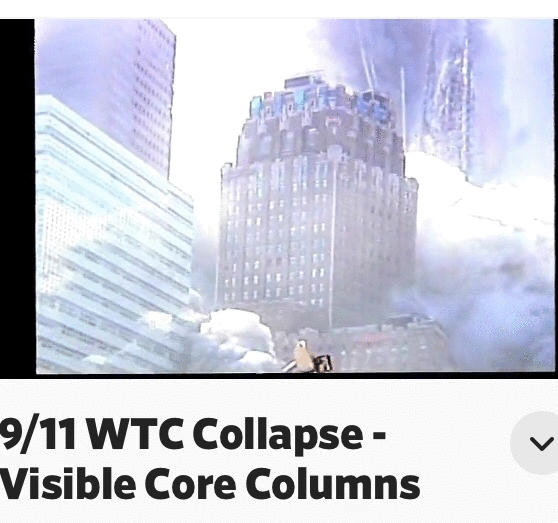
Donald Trump Calls Into WWOR/UPN 9 News on 9/11
The following image sequence is from the 1:45 min mark.

Your claims the following image is evidence of the core columns standing is false. It is clearly one of the corners of the building. it is interesting how it just evaporates?

a reply to: kwakakev
After the Hulsey report failure, AE is no dumbing down their campaign.
Good video on Mick West explaining why the truth movement is full of crap.
At about the 10 minute mark, it is explained the collapse of the twin towers was not through the cores with video evidence. The floors were torn from around the tube in tube design.
Again supported by the actual physical evidence
Except when the upper potion of the building above the Jet impact fell into the building below it broke floor connections. The core failing fist does not explain proven floor connections failures.
The below is supported by the video, audio, seismic evidence.
After the Hulsey report failure, AE is no dumbing down their campaign.
Good video on Mick West explaining why the truth movement is full of crap.
At about the 10 minute mark, it is explained the collapse of the twin towers was not through the cores with video evidence. The floors were torn from around the tube in tube design.
The Dumbing Down of Architects and Engineers for 9/11 Truth
m.youtube.com...
Again supported by the actual physical evidence
Except when the upper potion of the building above the Jet impact fell into the building below it broke floor connections. The core failing fist does not explain proven floor connections failures.
Failure of Welded Floor Truss Connections from the Exterior Wall during Collapse of the World Trade Center Towers
app.aws.org...
Analysis of the connections supporting the composite floor system of the WTC towers showed that at and below the im- pact floors, the greater majority (above 90%) of the floor truss connections were either bent downward or completely re- moved from the exterior column. This was probably related to the overloading of the floors below the impact region after col- lapse initiation. Depending upon weld joint geometry, detachment of the main load-bearing seats was a result of either fracture in the heat affected zone of the base material (standoff plate detached from spandrel) or through the weld metal (seat angle detached from standoff plate). Failure in both cases was assumed to be a result of a shear mechanism as a result of overloading from floors above impacting those below. There did not appear to be a significant change in distribution of failure modes of the floor truss connections when comparing those connections inside vs. outside of the impact region or those ex- posed to pre-collapse fires and those that were not.
The below is supported by the video, audio, seismic evidence.
The destruction of the Twin Towers has been called "the most infamous paradigm" of progressive collapse.[6] They began with the local failure of a few structural components and progressed to encompass the whole of the structure.[22] Such collapses are characterized by "the separation of structural components (including non-load bearing elements), the release of gravitational energy, and the occurrence of impact forces." The vertical impact force supplies the propagating action, the principal forces are parallel, and the primary load transfer is serial.[23] The key element in the structure that failed was constituted by the combined "vertical load-bearing members of one entire storey." Excepting the top floors of the building, which would not have released sufficient gravitational energy to bring about a total collapse, the collapses could have begun with the failure of any story.[24]
Under these conditions, the towers collapsed symmetrically and more or less straight down, though there was some tilting of the tops of the towers and a significant amount of fallout to the sides. In both cases, the section of the building that had been damaged by the airplanes failed, which allowed the floors above the impact zone to fall onto the undamaged structure below. As the collapse progressed, dust and debris could be seen shooting out of the windows several floors below the advancing destruction, caused by the sudden rush of air from the upper levels.
During each collapse, large portions of the perimeter columns and possibly the cores were left without any lateral support, causing them to fall laterally towards the outside, pushed by the increasing pile of rubble. The result was that the walls peeled off and separated away from the buildings by a large distance (about 500 feet in some cases), hitting other neighboring buildings, and starting fires that would later lead to the collapse of Building 7. Some connections broke as the bolts snapped, leaving many panels randomly scattered.[25] The first fragments of the outer walls of the collapsed North Tower struck the ground 11 seconds after the collapse started, and parts of the South Tower after 9 seconds. The lower portions of both buildings' cores (60 stories of WTC 1 and 40 stories of WTC 2) remained standing for up to 25 seconds after the start of the initial collapse before they too collapsed.[13]
Collapse initiation
After the planes struck the buildings, but before the buildings collapsed, the cores of both towers consisted of three distinct sections. Above and below the impact floors, the cores consisted of what were essentially two rigid boxes; the steel in these sections was undamaged and had undergone no significant heating. The section between them, however, had sustained significant damage and, though they were not hot enough to melt it, the fires were weakening the structural steel.
As a result, the core columns were slowly being crushed, sustaining plastic and creep deformation from the weight of floors above. As the top section tried to move downward, however, the hat truss redistributed the load to the perimeter columns. Meanwhile, the perimeter columns and floors were also being weakened by the heat of the fires, and as the floors began to sag they pulled the exterior walls inwards. "The ensuing loss in vertical load-carrying capacity was confined to a few storeys but extended over the entire cross section of each tower."[26] In the case of 2 WTC, the eastern face finally buckled, transferring its loads back to the failing core through the hat truss and initiating the collapse. Later, the south wall of 1 WTC buckled in the same way, and with similar consequences.[27]
en.m.wikipedia.org...
edit on 12-9-2020 by neutronflux because: Added more
a reply to: neutronflux
The vertical beams in one of the bottom corners got missed for some reason. I don't know why. Did not take long for it to fall apart with all the other damage going on.
for Richard Gages statements, what happened to the rest of the building? Looks true to me.
Richard Gage claimed all the vertical columns had to be cut to get a building to fall symmetrically? You said something about a corner left? So Richard Gages statement is false?
The vertical beams in one of the bottom corners got missed for some reason. I don't know why. Did not take long for it to fall apart with all the other damage going on.
for Richard Gages statements, what happened to the rest of the building? Looks true to me.
originally posted by: kwakakev
a reply to: neutronflux
Richard Gage claimed all the vertical columns had to be cut to get a building to fall symmetrically? You said something about a corner left? So Richard Gages statement is false?
The vertical beams in one of the bottom corners got missed for some reason. I don't know why. Did not take long for it to fall apart with all the other damage going on.
for Richard Gages statements, what happened to the rest of the building? Looks true to me.
Sorry. Evidence shows the core fell from loss of lateral support after the floor system failed.
The whole truth movement is based on created mythology, not the actual photographic, audio, video, seismic evidence, physical evidence.
Again...
originally posted by: neutronflux
a reply to: kwakakev
After the Hulsey report failure, AE is no dumbing down their campaign.
Good video on Mick West explaining why the truth movement is full of crap.
At about the 10 minute mark, it is explained the collapse of the twin towers was not through the cores with video evidence. The floors were torn from around the tube in tube design.
The Dumbing Down of Architects and Engineers for 9/11 Truth
m.youtube.com...
Again supported by the actual physical evidence
Except when the upper potion of the building above the Jet impact fell into the building below it broke floor connections. The core failing fist does not explain proven floor connections failures.
Failure of Welded Floor Truss Connections from the Exterior Wall during Collapse of the World Trade Center Towers
app.aws.org...
Analysis of the connections supporting the composite floor system of the WTC towers showed that at and below the im- pact floors, the greater majority (above 90%) of the floor truss connections were either bent downward or completely re- moved from the exterior column. This was probably related to the overloading of the floors below the impact region after col- lapse initiation. Depending upon weld joint geometry, detachment of the main load-bearing seats was a result of either fracture in the heat affected zone of the base material (standoff plate detached from spandrel) or through the weld metal (seat angle detached from standoff plate). Failure in both cases was assumed to be a result of a shear mechanism as a result of overloading from floors above impacting those below. There did not appear to be a significant change in distribution of failure modes of the floor truss connections when comparing those connections inside vs. outside of the impact region or those ex- posed to pre-collapse fires and those that were not.
The below is supported by the video, audio, seismic evidence.
The destruction of the Twin Towers has been called "the most infamous paradigm" of progressive collapse.[6] They began with the local failure of a few structural components and progressed to encompass the whole of the structure.[22] Such collapses are characterized by "the separation of structural components (including non-load bearing elements), the release of gravitational energy, and the occurrence of impact forces." The vertical impact force supplies the propagating action, the principal forces are parallel, and the primary load transfer is serial.[23] The key element in the structure that failed was constituted by the combined "vertical load-bearing members of one entire storey." Excepting the top floors of the building, which would not have released sufficient gravitational energy to bring about a total collapse, the collapses could have begun with the failure of any story.[24]
Under these conditions, the towers collapsed symmetrically and more or less straight down, though there was some tilting of the tops of the towers and a significant amount of fallout to the sides. In both cases, the section of the building that had been damaged by the airplanes failed, which allowed the floors above the impact zone to fall onto the undamaged structure below. As the collapse progressed, dust and debris could be seen shooting out of the windows several floors below the advancing destruction, caused by the sudden rush of air from the upper levels.
During each collapse, large portions of the perimeter columns and possibly the cores were left without any lateral support, causing them to fall laterally towards the outside, pushed by the increasing pile of rubble. The result was that the walls peeled off and separated away from the buildings by a large distance (about 500 feet in some cases), hitting other neighboring buildings, and starting fires that would later lead to the collapse of Building 7. Some connections broke as the bolts snapped, leaving many panels randomly scattered.[25] The first fragments of the outer walls of the collapsed North Tower struck the ground 11 seconds after the collapse started, and parts of the South Tower after 9 seconds. The lower portions of both buildings' cores (60 stories of WTC 1 and 40 stories of WTC 2) remained standing for up to 25 seconds after the start of the initial collapse before they too collapsed.[13]
Collapse initiation
After the planes struck the buildings, but before the buildings collapsed, the cores of both towers consisted of three distinct sections. Above and below the impact floors, the cores consisted of what were essentially two rigid boxes; the steel in these sections was undamaged and had undergone no significant heating. The section between them, however, had sustained significant damage and, though they were not hot enough to melt it, the fires were weakening the structural steel.
As a result, the core columns were slowly being crushed, sustaining plastic and creep deformation from the weight of floors above. As the top section tried to move downward, however, the hat truss redistributed the load to the perimeter columns. Meanwhile, the perimeter columns and floors were also being weakened by the heat of the fires, and as the floors began to sag they pulled the exterior walls inwards. "The ensuing loss in vertical load-carrying capacity was confined to a few storeys but extended over the entire cross section of each tower."[26] In the case of 2 WTC, the eastern face finally buckled, transferring its loads back to the failing core through the hat truss and initiating the collapse. Later, the south wall of 1 WTC buckled in the same way, and with similar consequences.[27]
en.m.wikipedia.org...
This is like debating over how the Roadrunner could have run right through a solid rock mountain, after a black 'hole' was painted on it!
Those who believe it happened challenge others to prove it did not happen, after half the mountain was shipped to China.
Idiots who don't believe it debate about what the mountain was made of, and that the hole was only painted on the mountain. Those who believe it happened say 'where's the bucket of paint?' The other side says it was removed at the scene, before an investigation started.
The believers create their 'account' of it, with pages and pages of words that say nothing. But it's debated over by the other side, on all the details, forever afterwards. Nothing else matters to them, except to keep on debating about these details.
That's just like it is for 9/11, sad to say.
If everyone simply demanded - THAT THEY REPLICATE THIS WITH REAL MODELS - nobody would try to debate over details from a report, or what a video clip shows, or anything else. It doesn't matter, because all that matters is if it can be replicated with real world demonstrations, or cannot. If it can, there's no debate. If it cannot, there's no debate.
We know it cannot be replicated, so there's nothing to debate over and over again here. It was not caused by fire and damage, because it cannot be replicated with real models.
If everyone here understood that their story is a complete fairy tale, that cannot be replicated in the real world, then we are on the right path. Everyone has to realize this, because debating side issues doesn't matter at all, it's fool's play. Just a bunch of red herrings, in other words. They avoid the one issue that matters, and that's what they want us to do. Forget the only issue that matters, and just debate the side issues, over and over again.
It's time to end their game, and prove they are all liars, who cannot replicate what they've kept on claiming, because it's simply a lie, a fairy tale story.
Those who believe it happened challenge others to prove it did not happen, after half the mountain was shipped to China.
Idiots who don't believe it debate about what the mountain was made of, and that the hole was only painted on the mountain. Those who believe it happened say 'where's the bucket of paint?' The other side says it was removed at the scene, before an investigation started.
The believers create their 'account' of it, with pages and pages of words that say nothing. But it's debated over by the other side, on all the details, forever afterwards. Nothing else matters to them, except to keep on debating about these details.
That's just like it is for 9/11, sad to say.
If everyone simply demanded - THAT THEY REPLICATE THIS WITH REAL MODELS - nobody would try to debate over details from a report, or what a video clip shows, or anything else. It doesn't matter, because all that matters is if it can be replicated with real world demonstrations, or cannot. If it can, there's no debate. If it cannot, there's no debate.
We know it cannot be replicated, so there's nothing to debate over and over again here. It was not caused by fire and damage, because it cannot be replicated with real models.
If everyone here understood that their story is a complete fairy tale, that cannot be replicated in the real world, then we are on the right path. Everyone has to realize this, because debating side issues doesn't matter at all, it's fool's play. Just a bunch of red herrings, in other words. They avoid the one issue that matters, and that's what they want us to do. Forget the only issue that matters, and just debate the side issues, over and over again.
It's time to end their game, and prove they are all liars, who cannot replicate what they've kept on claiming, because it's simply a lie, a fairy tale story.
When most people look at 9/11, they see everyone on each side of the issue, debating over technical details, structural design, strength of steel,
melting points of steel, what is shown in videos, and so on. One side claims there is evidence of explosives, the other side says there is no evidence
of explosives. They debate what type of explosives were used, how they planted them, where they were planted, how they could work after plane impacts,
etc.
Most people don't understand structural engineering, or technical matters, or pyrotechnics, which are always part of the debates about 9/11.
If we simply demanded that they replicate it, with real models, and if they refuse, or cannot replicate it, everyone would know they are liars. Nobody needs to know structural engineering, or physics, or whatever else, they just have to know that if it cannot be replicated, it is false, a lie. That is the proof right there, in front of us.
Most people don't understand structural engineering, or technical matters, or pyrotechnics, which are always part of the debates about 9/11.
If we simply demanded that they replicate it, with real models, and if they refuse, or cannot replicate it, everyone would know they are liars. Nobody needs to know structural engineering, or physics, or whatever else, they just have to know that if it cannot be replicated, it is false, a lie. That is the proof right there, in front of us.
If we simply demanded that they replicate it, with real models, and if they refuse, or cannot replicate it, everyone would know they are liars.
The way WCT7 fell has been replicated plenty of times. Some just too invested in the official story I guess?
originally posted by: kwakakev
If we simply demanded that they replicate it, with real models, and if they refuse, or cannot replicate it, everyone would know they are liars.
The way WCT7 fell has been replicated plenty of times. Some just too invested in the official story I guess?
Are you referring to the Hulsey model that is missing key collapse features?
And....
originally posted by: neutronflux
originally posted by: democracydemo
a reply to: OtherSideOfTheCoin
Who the **** would you like it to be sponsored by? What source would do it neutral for you? Take a look at the results and Revisit.
The study is very flawed.
UAF WTC 7 Evaluation Simulation Plausibility Check (Leroy Hulsey, AE911Truth)
m.youtube.com...
a reply to: turbonium1
You
Well, good thing there are multiple photos, video of the collapsing building from different angles, audio, seismic evidence, documentation of the debris, and structural steel of the towers in memorials around the world.
And the reports and accounts that WTC 7 was failing and predicted to collapse.
Again
originally posted by: neutronflux
Except when the upper potion of the building above the Jet impact fell into the building below it broke floor connections. The core failing fist does not explain proven floor connections failures.
The below is supported by the video, audio, seismic evidence.
You have an explanation for the type of floor connection failures?
You
If we simply demanded that they replicate it, with real models, and if they refuse, or cannot replicate it, e
Well, good thing there are multiple photos, video of the collapsing building from different angles, audio, seismic evidence, documentation of the debris, and structural steel of the towers in memorials around the world.
And the reports and accounts that WTC 7 was failing and predicted to collapse.
Again
originally posted by: neutronflux
originally posted by: democracydemo
originally posted by: neutronflux
originally posted by: democracydemo
a reply to: neutronflux
Yes indeed and we witnessed this:
www.metabunk.org...
See you cannot articulate a proper response.
Why would i? You gone and done this already:
the the core columns would have simultaneous pulled down the outer vertical columns (the vertical columns holding up the floor opposite of the core columns, and were part of the towers cores) via the floor trusses.
www.metabunk.org...
Except when the upper potion of the building above the Jet impact fell into the building below it broke floor connections. The core failing fist does not explain proven floor connections failures.
Failure of Welded Floor Truss Connections from the Exterior Wall during Collapse of the World Trade Center Towers
app.aws.org...
Analysis of the connections supporting the composite floor system of the WTC towers showed that at and below the im- pact floors, the greater majority (above 90%) of the floor truss connections were either bent downward or completely re- moved from the exterior column. This was probably related to the overloading of the floors below the impact region after col- lapse initiation. Depending upon weld joint geometry, detachment of the main load-bearing seats was a result of either fracture in the heat affected zone of the base material (standoff plate detached from spandrel) or through the weld metal (seat angle detached from standoff plate). Failure in both cases was assumed to be a result of a shear mechanism as a result of overloading from floors above impacting those below. There did not appear to be a significant change in distribution of failure modes of the floor truss connections when comparing those connections inside vs. outside of the impact region or those ex- posed to pre-collapse fires and those that were not.
The below is supported by the video, audio, seismic evidence.
The destruction of the Twin Towers has been called "the most infamous paradigm" of progressive collapse.[6] They began with the local failure of a few structural components and progressed to encompass the whole of the structure.[22] Such collapses are characterized by "the separation of structural components (including non-load bearing elements), the release of gravitational energy, and the occurrence of impact forces." The vertical impact force supplies the propagating action, the principal forces are parallel, and the primary load transfer is serial.[23] The key element in the structure that failed was constituted by the combined "vertical load-bearing members of one entire storey." Excepting the top floors of the building, which would not have released sufficient gravitational energy to bring about a total collapse, the collapses could have begun with the failure of any story.[24]
Under these conditions, the towers collapsed symmetrically and more or less straight down, though there was some tilting of the tops of the towers and a significant amount of fallout to the sides. In both cases, the section of the building that had been damaged by the airplanes failed, which allowed the floors above the impact zone to fall onto the undamaged structure below. As the collapse progressed, dust and debris could be seen shooting out of the windows several floors below the advancing destruction, caused by the sudden rush of air from the upper levels.
During each collapse, large portions of the perimeter columns and possibly the cores were left without any lateral support, causing them to fall laterally towards the outside, pushed by the increasing pile of rubble. The result was that the walls peeled off and separated away from the buildings by a large distance (about 500 feet in some cases), hitting other neighboring buildings, and starting fires that would later lead to the collapse of Building 7. Some connections broke as the bolts snapped, leaving many panels randomly scattered.[25] The first fragments of the outer walls of the collapsed North Tower struck the ground 11 seconds after the collapse started, and parts of the South Tower after 9 seconds. The lower portions of both buildings' cores (60 stories of WTC 1 and 40 stories of WTC 2) remained standing for up to 25 seconds after the start of the initial collapse before they too collapsed.[13]
Collapse initiation
After the planes struck the buildings, but before the buildings collapsed, the cores of both towers consisted of three distinct sections. Above and below the impact floors, the cores consisted of what were essentially two rigid boxes; the steel in these sections was undamaged and had undergone no significant heating. The section between them, however, had sustained significant damage and, though they were not hot enough to melt it, the fires were weakening the structural steel.
As a result, the core columns were slowly being crushed, sustaining plastic and creep deformation from the weight of floors above. As the top section tried to move downward, however, the hat truss redistributed the load to the perimeter columns. Meanwhile, the perimeter columns and floors were also being weakened by the heat of the fires, and as the floors began to sag they pulled the exterior walls inwards. "The ensuing loss in vertical load-carrying capacity was confined to a few storeys but extended over the entire cross section of each tower."[26] In the case of 2 WTC, the eastern face finally buckled, transferring its loads back to the failing core through the hat truss and initiating the collapse. Later, the south wall of 1 WTC buckled in the same way, and with similar consequences.[27]
en.m.wikipedia.org...
You have an explanation for the type of floor connection failures?
edit on 13-9-2020 by neutronflux because: Added and fixed
a reply to: neutronflux
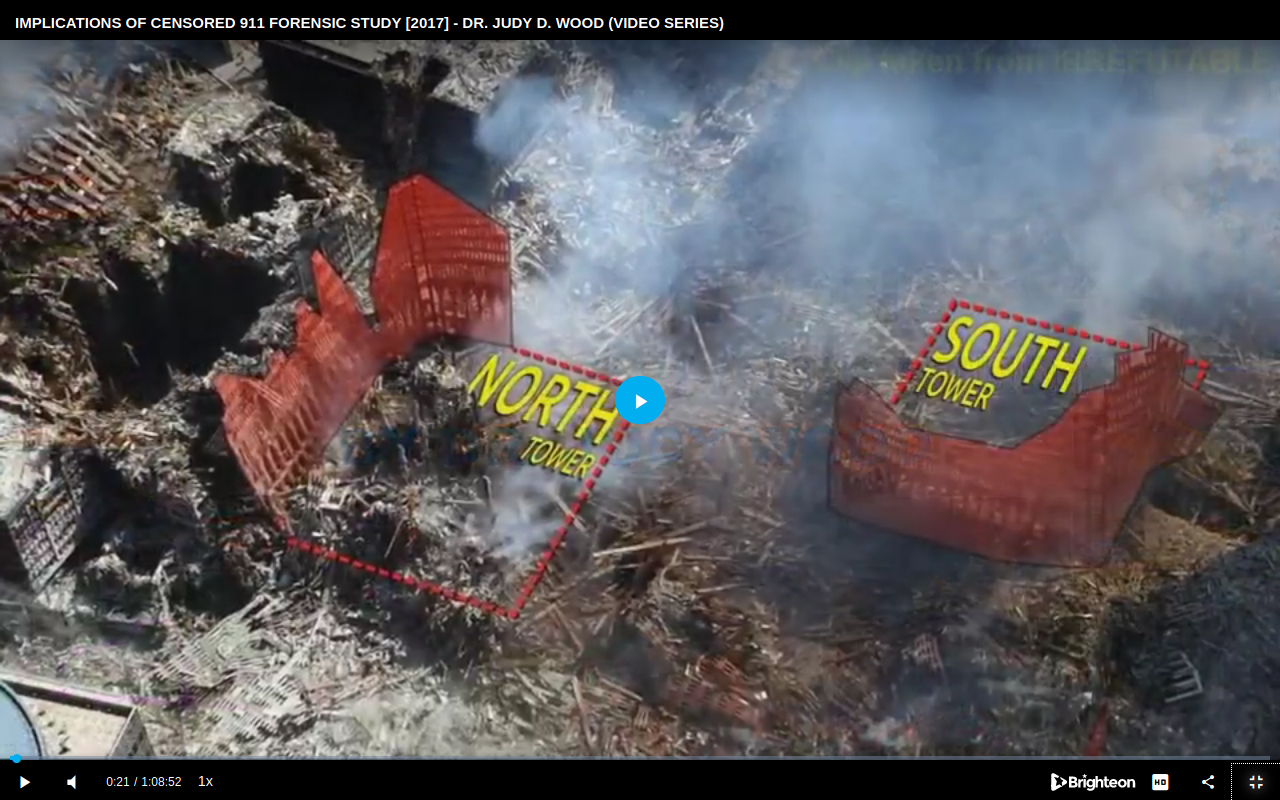
Here is more evidence that your claims of the core columns remained standing is false. This photo clearly shows there are two holes where the core columns where. There is still a little of the outer walls still standing once all the dust settled.
The photos you use as evidence of the core columns standing is of the outer walls.

Here is more evidence that your claims of the core columns remained standing is false. This photo clearly shows there are two holes where the core columns where. There is still a little of the outer walls still standing once all the dust settled.
The photos you use as evidence of the core columns standing is of the outer walls.
originally posted by: kwakakev
a reply to: neutronflux
Here is more evidence that your claims of the core columns remained standing is false. This photo clearly shows there are two holes where the core columns where. There is still a littleof the outer walls still standing once all the dust settled.
The photos you use as evidence of the core columns standing is of the outer walls.
Nice try at a blatant falsehood.
How does a picture after the collapse show I am wrong? In that the core of the tube in tube design fell after the collapse of the floor system? And the core failure from loss of lateral support?
One...
3WHAT ABOUT THE ALMOST FREE-FALL COLLAPSE OF THE TWIN TOWERS? The key is the “almost” modifier. If I told you I was making almost $100,000 and you found out I was making only $67,000, you’d say I was exaggerating. So stop exaggerating the collapse speed of the WTC Towers! The 80,000 tons of structural steel slowed down the collapses of the Twin Towers to about ⅔ (two-thirds) of free-fall.3 And the core collapsed at about 40% of free-fall speed, coming down last.4 According to Richard Gage: “To bring a building symmetrically down, what we have to do is remove the core columns.” But on 9/11 the stronger core columns came down last, which violates this supposed most fundamental rule of controlled demolition.
www.skeptic.com...
Two....
At about the 10 minute mark, it is explained the collapse of the twin towers was not through the cores with video evidence. The floors were torn from around the tube in tube design.
The Dumbing Down of Architects and Engineers for 9/11 Truth
Three
From video evidence, significant portions of the cores of both buildings (roughly 60 stories of WTC 1 and 40 stories of WTC 2) are known to have stood 15 to 25 seconds after collapse initiation before they, too, began to collapse. Neither the duration of the seismic records nor video evidence (due to obstruction of view caused by debris clouds) are reliable indicators of the total time it took for each building to collapse completely.
www.nist.gov...
Three different sources that agree by looking at the video evidence, the core fell after being stripped of the floor system. The core columns tumbled outward after loss of the lateral support of the floor system?
Now. This American welding report
Failure of Welded Floor Truss Connections from the Exterior Wall during Collapse of the World Trade Center Towers
app.aws.org...
The Americans Welding Report clearly states...
“ the greater majority (above 90%) of the floor truss connections were either bent downward or completely re- moved from the exterior column.”
That means a falling load bent or removed the floor connections. That means the core columns and the exterior columns were still supporting the floors when the upper portion of the building above the jet impacts fell into the building below smashing floors.
That also means no planted pyrotechnics initiated the collapse because no controlled demolition system would have survived the jet impacts and fires to initiate.
Now, this screenshot of core columns tumbling after the loss of the floor system.
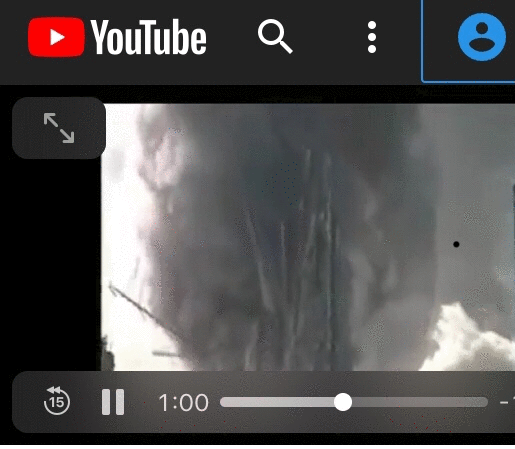
How do we know the long single columns falling over one by one were not exterior panels as you claim. Because the columns falling over in the screenshot look like core columns, and noting like the exterior panels of the twin towers’ outer wall.
The exterior panels where sections with three vertical columns.
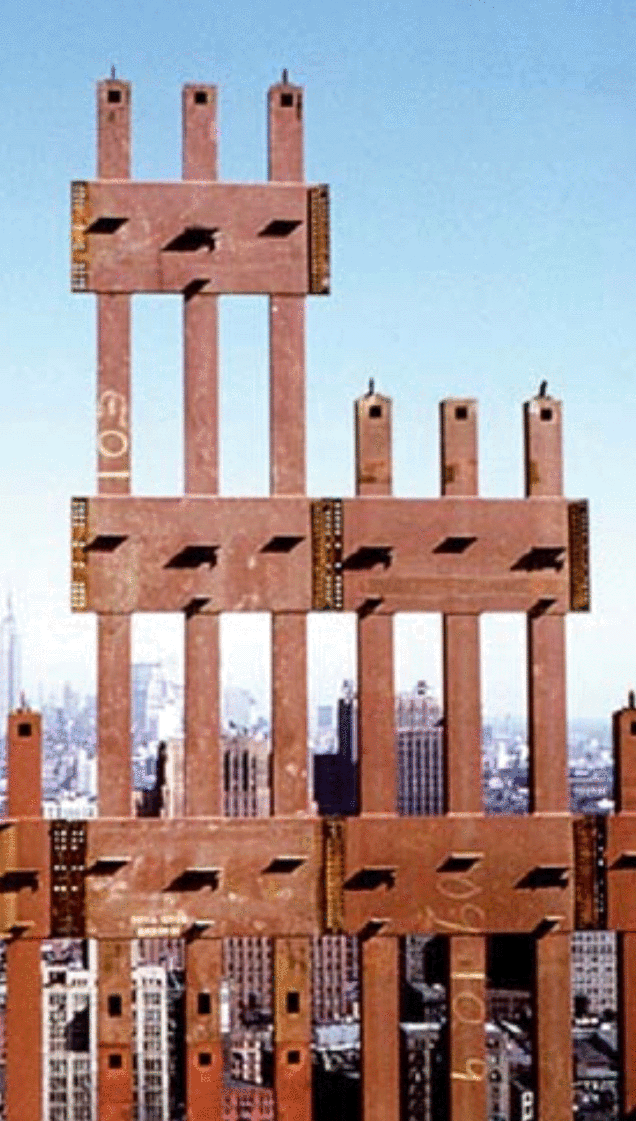
www.fema.gov...
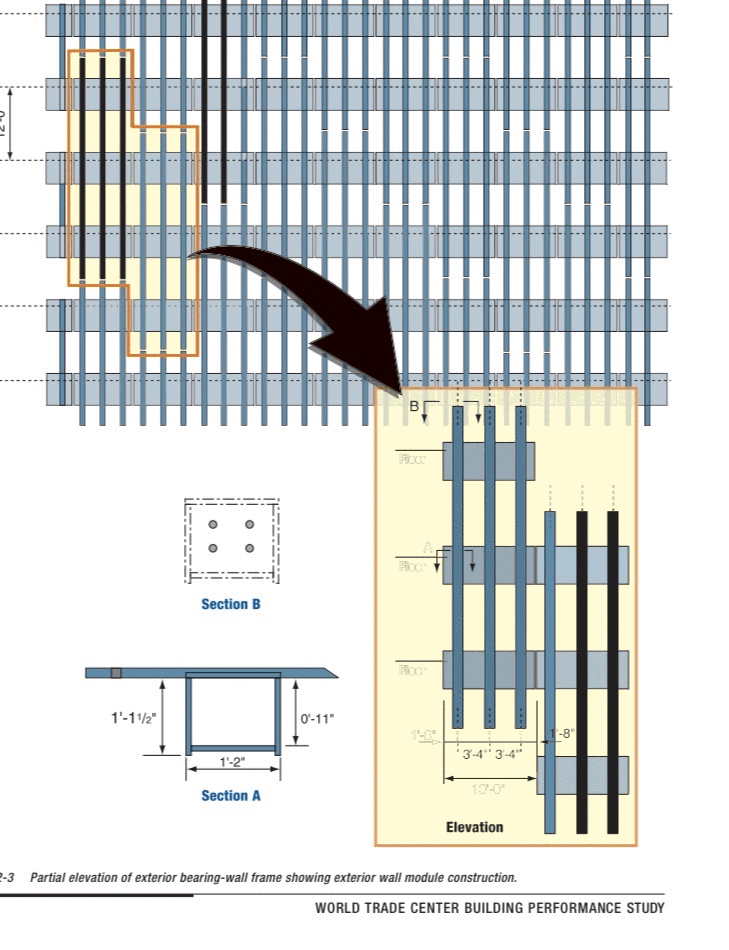
www.fema.gov...
When the exterior panels collapse, they fractured into their original prefabricated state as shown in the photos of the collapse pile. Panels with three vertical columns two to three stories tall.
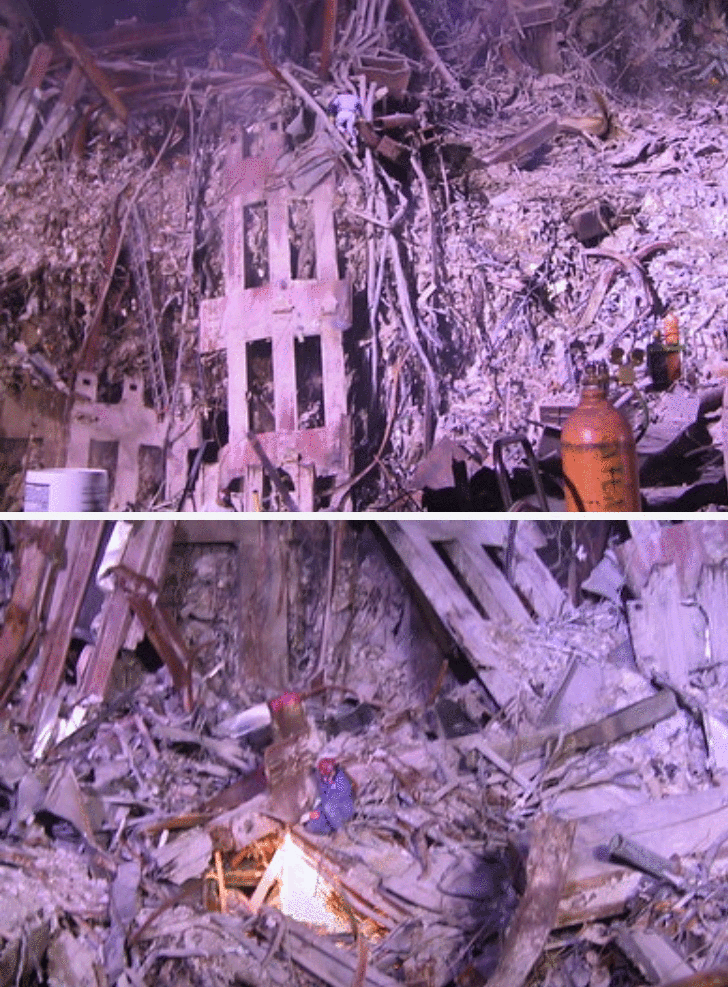
www.flickr.com...
Again...

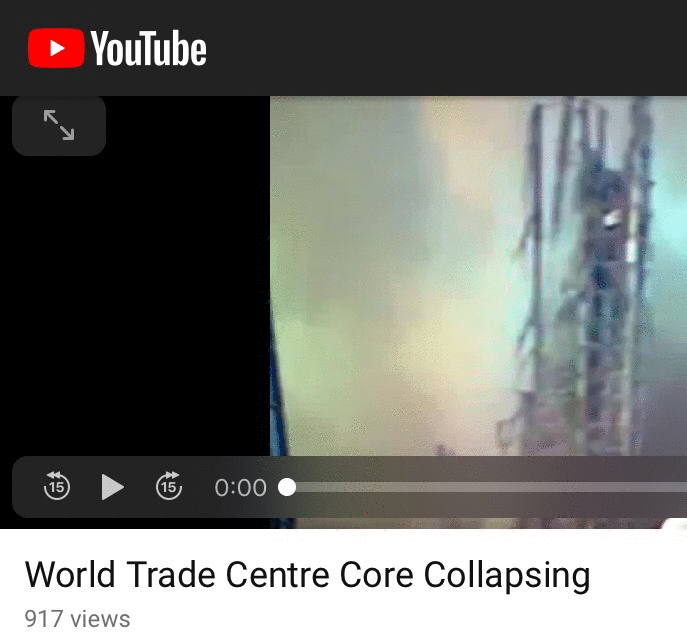
The long single vertical columns falling over after the complete collapse of the floor system that do not show indication of being a prefabricate panel only about two to three stories tall with three vertical columns are the vertical columns.
The panels breaking into sections with three vertical columns are the exterior panels, or exterior walls that held up the floors opposite the core columns.
The long single vertical columns that look like they housed elevator shafts falling over one after another are the core columns failing after being stripped of the floor system.
edit on 13-9-2020 by neutronflux because: Added and fixed
edit on 13-9-2020 by neutronflux because: Fixed more
new topics
-
Watch as a 12 million years old Crab Emerges from a Rock
Ancient & Lost Civilizations: 47 minutes ago -
ILLUMINATION: Dimensions / Degrees – Da Vincis Last Supper And The Philosophers Stone
Secret Societies: 6 hours ago -
Just Sick of It! Done! Can't take it anymore!
General Chit Chat: 8 hours ago -
Speaking of Pandemics
General Conspiracies: 9 hours ago -
Stuck Farmer And His Queue Jumping Spawn
Rant: 9 hours ago
top topics
-
Paradox of Progress
Ancient & Lost Civilizations: 17 hours ago, 8 flags -
Speaking of Pandemics
General Conspiracies: 9 hours ago, 8 flags -
ILLUMINATION: Dimensions / Degrees – Da Vincis Last Supper And The Philosophers Stone
Secret Societies: 6 hours ago, 7 flags -
Just Sick of It! Done! Can't take it anymore!
General Chit Chat: 8 hours ago, 5 flags -
Stuck Farmer And His Queue Jumping Spawn
Rant: 9 hours ago, 4 flags -
Watch as a 12 million years old Crab Emerges from a Rock
Ancient & Lost Civilizations: 47 minutes ago, 2 flags
active topics
-
Candidate Harris Supporter MARK CUBAN Says Trump Has No Smart-Intelligent Women in His Orbit.
2024 Elections • 80 • : WeMustCare -
Undiagnosed China Pneumonia Reported
Diseases and Pandemics • 47 • : tarantulabite1 -
Winter Storm
Fragile Earth • 29 • : Flyingclaydisk -
Musk calls on King Charles III to dissolve Parliament over Oldham sex grooming gangs
Mainstream News • 162 • : andy06shake -
Nigel Farage's New Year Message.
Politicians & People • 23 • : DISRAELI2 -
Joe Biden gives the USA's Highest Civilian Honor Award to Hillary Clinton and George Soros.
US Political Madness • 36 • : Flyingclaydisk -
-@TH3WH17ERABB17- -Q- ---TIME TO SHOW THE WORLD--- -Part- --44--
Dissecting Disinformation • 3935 • : Thoughtful3 -
DONALD J. TRUMP - TIME's Most Extraordinary Person of the Year 2024.
Mainstream News • 59 • : WeMustCare -
Watch as a 12 million years old Crab Emerges from a Rock
Ancient & Lost Civilizations • 1 • : Oldcarpy2 -
Paranoid Liberals Believe U.S. Service Members are More Dangerous than Illegal Aliens.
Social Issues and Civil Unrest • 49 • : WeMustCare

